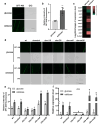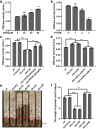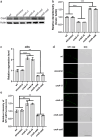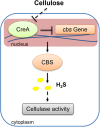The CBS/H2S signalling pathway regulated by the carbon repressor CreA promotes cellulose utilization in Ganoderma lucidum
- PMID: 38632386
- PMCID: PMC11024145
- DOI: 10.1038/s42003-024-06180-y
The CBS/H2S signalling pathway regulated by the carbon repressor CreA promotes cellulose utilization in Ganoderma lucidum
Abstract
Cellulose is an important abundant renewable resource on Earth, and the microbial cellulose utilization mechanism has attracted extensive attention. Recently, some signalling molecules have been found to regulate cellulose utilization and the discovery of underlying signals has recently attracted extensive attention. In this paper, we found that the hydrogen sulfide (H2S) concentration under cellulose culture condition increased to approximately 2.3-fold compared with that under glucose culture condition in Ganoderma lucidum. Further evidence shown that cellulase activities of G. lucidum were improved by 18.2-27.6% through increasing H2S concentration. Then, we observed that the carbon repressor CreA inhibited H2S biosynthesis in G. lucidum by binding to the promoter of cbs, a key gene for H2S biosynthesis, at "CTGGGG". In our study, we reported for the first time that H2S increased the cellulose utilization in G. lucidum, and analyzed the mechanism of H2S biosynthesis induced by cellulose. This study not only enriches the understanding of the microbial cellulose utilization mechanism but also provides a reference for the analysis of the physiological function of H2S signals.
© 2024. The Author(s).
Conflict of interest statement
The authors declare no competing interest.
Figures







Similar articles
-
Hydrogen sulfide maintains mitochondrial homeostasis and regulates ganoderic acids biosynthesis by SQR under heat stress in Ganoderma lucidum.Redox Biol. 2024 Aug;74:103227. doi: 10.1016/j.redox.2024.103227. Epub 2024 Jun 6. Redox Biol. 2024. PMID: 38865903 Free PMC article.
-
In Ganoderma lucidum, Glsnf1 regulates cellulose degradation by inhibiting GlCreA during the utilization of cellulose.Environ Microbiol. 2020 Jan;22(1):107-121. doi: 10.1111/1462-2920.14826. Epub 2019 Oct 28. Environ Microbiol. 2020. PMID: 31608522
-
Hydrogen sulfide, a novel small molecule signalling agent, participates in the regulation of ganoderic acids biosynthesis induced by heat stress in Ganoderma lucidum.Fungal Genet Biol. 2019 Sep;130:19-30. doi: 10.1016/j.fgb.2019.04.014. Epub 2019 Apr 24. Fungal Genet Biol. 2019. PMID: 31028914
-
Mechanisms Underlying the Hydrogen Sulfide Actions: Target Molecules and Downstream Signaling Pathways.Antioxid Redox Signal. 2024 Jan;40(1-3):86-109. doi: 10.1089/ars.2023.0401. Epub 2023 Sep 5. Antioxid Redox Signal. 2024. PMID: 37548532 Review.
-
Shedding light on the mechanisms underlying the environmental regulation of secondary metabolite ganoderic acid in Ganoderma lucidum using physiological and genetic methods.Fungal Genet Biol. 2019 Jul;128:43-48. doi: 10.1016/j.fgb.2019.03.009. Epub 2019 Apr 2. Fungal Genet Biol. 2019. PMID: 30951869 Review.
Cited by
-
Hydrogen sulfide maintains mitochondrial homeostasis and regulates ganoderic acids biosynthesis by SQR under heat stress in Ganoderma lucidum.Redox Biol. 2024 Aug;74:103227. doi: 10.1016/j.redox.2024.103227. Epub 2024 Jun 6. Redox Biol. 2024. PMID: 38865903 Free PMC article.
-
The APSES transcription factor Swi6B upregulates CATALASE 1 transcription to enhance oxidative stress tolerance of Ganoderma lucidum.Appl Environ Microbiol. 2025 Jul 23;91(7):e0067925. doi: 10.1128/aem.00679-25. Epub 2025 Jun 18. Appl Environ Microbiol. 2025. PMID: 40530877 Free PMC article.
-
Fungal L-Methionine Biosynthesis Pathway Enzymes and Their Applications in Various Scientific and Commercial Fields.Biomolecules. 2024 Oct 17;14(10):1315. doi: 10.3390/biom14101315. Biomolecules. 2024. PMID: 39456248 Free PMC article. Review.
References
Publication types
MeSH terms
Substances
Grants and funding
LinkOut - more resources
Full Text Sources

